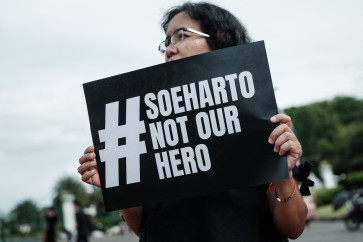Popular Reads
Top Results
Can't find what you're looking for?
View all search resultsPopular Reads
Top Results
Can't find what you're looking for?
View all search resultsBekasi residents still clearing mud from homes
Not over yet: Murniasih, 40, stands in front of her house in the Pondok Gede Permai housing complex in Bekasi on Tuesday
Change text size
Gift Premium Articles
to Anyone
N
ot over yet: Murniasih, 40, stands in front of her house in the Pondok Gede Permai housing complex in Bekasi on Tuesday. The first floor is still unusable even though she has been cleaning for nearly two weeks after torrential rains caused widespread flooding in Greater Jakarta and Banten province on Jan. 1. (JP/Alya Nurbaiti)
Two weeks after major flooding hit Greater Jakarta on New Year's Day, people have yet to resume their daily activities in Jatiasih district, Bekasi, which continues to battle the mud left behind.
Mud five to 20 centimeters deep still covers some road sections in the district's Pondok Gede Permai housing complex, where daily activities have been at a standstill for the last two weeks.
Dudung, a baker and the head of neighborhood unit (RT) 1 in the complex, said he had not been able to bake or sell baked goods since the flood.
“I think other people who don’t work from home like I do are a little luckier. Every day is cleaning day for me,” said the 45-year-old baker on Tuesday.
“Thankfully, there are always people from I don’t know where who distribute food,” he added.
Dudung and many other residents are still dependent on food aid, even though they have returned to their homes.
Many local residents were spotted on Tuesday sloshing through the mud in boots, while firefighters pumped high-pressure water to clear the mud-filled gutters. At least two small backhoes were seen excavating residual mud in the area.
The Indonesian Military and civil servants are also helping the residents clear out the mud, armed with squeegees, hoses and hoes.
Murniasih, 40, said she had been sleeping at an emergency post at the nearby National Disaster Mitigation Agency (BNPB) warehouse, and returned to her house during the day to continue with the cleaning.
However, the post was closed for the first time on Tuesday, so Murniasih and her family would be sleeping on the second floor of their house. The first floor was still a mess.
“We will be sleeping on a rug, since our beds were soaked through and nothing could be done but to throw them away,” she said.
“We have been cleaning for 12 days straight. But the walls inside my house are still dirty,” said 60-year-old Tarikem, another resident of RT 1. She added that she still had a long way to go in cleaning her house, which had taken a month to dry out in the previous flood.
“I don’t want to get too tired and stressed out, so I'm doing the cleaning a little at a time. I'm just trying to keep it fun,” she said.
The Bekasi Public Facility Maintenance Agency had arrived only on Monday to collect the garbage, but dirty mattresses, ruined furniture and piles of other trash were left behind.
Pondok Gede Permai is one of several areas Bekasi authorities were still cleaning two weeks after the flood, along with the Jatibening Marine Complex, Kemang Ifi Graha, Villa Jatirasa and Pondok Mitra Lestari.
Bekasi was one of the worst-hit in the capital, with 32 flooded areas in Bekasi regency and 53 in Bekasi municipality.
According to the BNPB, the flood affected 169 areas across Greater Jakarta and Banten: 63 areas in Jakarta, 12 in Bogor and nine in Banten.
Bekasi Environmental Agency head Yayan Yuliana said that the local administration had been deploying 15,000 personnel from all work units every day since the floodwaters had receded.
“But the cleanup has not finished yet because the affected area is very large and we are cleaning [them] step by step,” he said, adding that the units collected 1,500 tons of flood waste each day.
Pondok Gede Permai was built in 1988 in a depression off the main road that was formerly the site of rice fields and swampland, according to Widodo, 67, who has lived in RT 6 of the complex since 1990.
“It’s like our houses have been built inside a pan,” said Widodo.
The outer edge of the housing complex is only 3 meters from the dike built where the Bekasi, Cikeas and Cileungsi rivers converge. A surge of water broke through the dike and into the housing complex following the torrential rain on New Year’s Eve, flooding it with water up to six meters high. The fast-flowing floodwater brought a great amount of mud with it.
Living in such a low-lying area, the residents of Pondok Gede Permai have had their share of floods, ranging from 30 cm to four meters high during 2016.
But this year's flooding was the worst they had experienced, and some residents hoped to be relocated to a new house, said 45-year-old Bambang Widiantono of RT 1.
Earth sciences and disaster mitigation expert Junun Sartohadi of Gadjah Mada University said that the flooding was to be expected, as rice fields and swampland were low-lying areas that naturally held water. He added that the condition would be worse if the area did not have a good drainage system.
Junun said flooding was a problem caused by development that altered the natural function of land without a comprehensive stream flow management plan.
The 2007 Spatial Planning Law stipulates that 30 percent of a city should be managed as green space, one function which is to absorb rainwater. Only 10 percent of Bekasi was green space in 2015. (aly)










